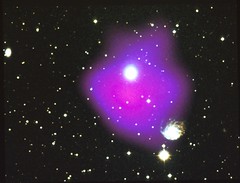Although it would seem that the human eye gives us a pretty accurate view of the world, we are literally blind to much of what surrounds us. A whole Universe of color exists, only a thin band of which our eyes are able to detect; an example of this visible range of color is the familiar concept of a rainbow or a spectrum. The optical spectrum ranges in color from reds and oranges up through blues and purples. Each of these colors actually corresponds to a different energy of light. The colors or energies of light that our eyes cannot see also have names that are familiar to us.
We listen to radios…

…we eat food heated in microwaves…

…we have X-rays taken of our broken bones.

Yet radio, X-ray, and microwave are really energies of light! The entire range of energies of light, including both light we can see and light we cannot see, is called the electromagnetic spectrum. It includes, from highest energy to lowest: gamma-rays, X-rays, ultraviolet, optical, infrared, microwaves, and radio waves.


Because we can only see visible light, we are put at a disadvantage because the Universe is actively emitting light at all these different energies.
For instance, because of X-ray telescopes, we know that most of the mass of a cluster of galaxies consists of hot gases that emit X-rays but are invisible at optical wavelengths. Because we can't see X-rays, we had no way of knowing this until we thought to look at the skies with electronic eyes. If we hadn't learned about these hot clouds of X-ray emitting gas, we wouldn't know how galaxies, like these ones that were imaged by both the Hubble Space Telescope and ROSAT, form and evolve!